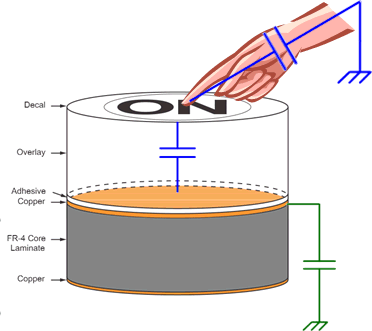SLAA842B December 2018 – August 2019 DS90C401 , DS90C402 , MSP430FR2512 , MSP430FR2522 , MSP430FR2532 , MSP430FR2533 , MSP430FR2632 , MSP430FR2633 , MSP430FR2672 , MSP430FR2673 , MSP430FR2675 , MSP430FR2676
3 Step 1: Understand the Basics of Capacitive Touch Sensing and CapTIvate Technology
The first step of designing a successful capacitive touch sensing system is to understand the basic principles of capacitive touch sensing. Capacitive sensing performs a measurement to detect a change in the capacitance of a sensor element. A sensor element can be any conductive material (for example, a copper PCB plane or a wire). The change can be due to human interaction, such as a finger, ear, or hand. This is often termed capacitive touch, and Figure 2 shows the stackup of a basic capacitive touch design.
For additional information, visit Capacitive Sensing Basics.
 Figure 2. Stackup of Basic Capacitive Touch Design
Figure 2. Stackup of Basic Capacitive Touch Design Two different capacitive sensing measurement methods are available: self capacitance and mutual capacitance. Table 1 compares these two sensing measurement methods. Review the fundamentals of these two sensing methods to choose the one that best suits the application requirements. CapTIvate MCUs support both sensing methods in a single design.
For additional information, visit these topics:
Table 1. Comparison of Self Capacitance and Mutual Capacitance
At this point, you should have a good understanding of the capacitive touch sensing fundamentals. Refer to these topics to find out how TI CapTIvate technology applies these fundamentals: